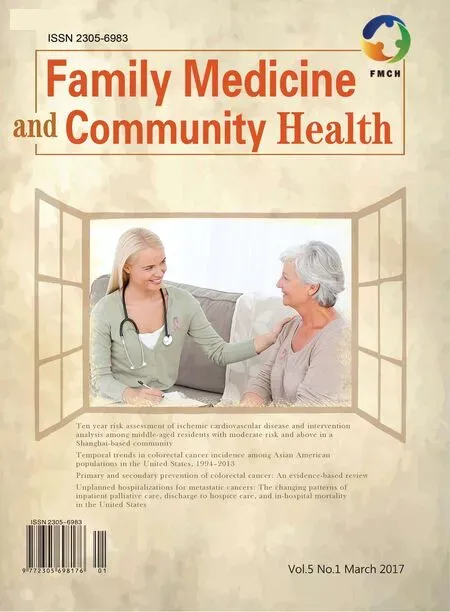The global burden of preventable cancer mortality
Roger J. Zoorob
The global burden of preventable cancer mortality
Roger J. Zoorob
I am pleased to present this special issue of Family Medicine and Community Health,entitled “The Global Burden of Preventable Cancer Mortality.” This issue was completed in collaboration with the Baylor College of Medicine (BCM) Department of Family and Community Medicine in Houston, Texas, USA.The mission of the department is to enhance population health and advance the primary care discipline through rigorous and evidencebased prevention and research. We focus our research efforts on a broad range of research areas including, but not limited to, cancer control, nutrition and health, medical education,and health disparities.
Herein we explore key issues in global cancer mortality and prevention. According to estimates from the World Health Organization’s International Agency for Research on Cancer(IARC), of 14 million new cancer cases in 2012, 8 million occurred in low-middle income countries (which contain 82% of the world’s population). Cancer deaths totaled 8.2 million(with 70% in low- and middle-income countries), and estimates show there were 32.6 million people living with cancer (within fi ve years of diagnosis) worldwide. By 2030, the global burden is expected to grow to 21.7 million new cancer cases and 13 million cancer deaths. This is due in part to the growth and aging of populations, but there are many factors and questions to investigate.
Worldwide in 2012, the three most commonly diagnosed cancers were lung, bronchus,and trachea. Prostate, colon and rectum are the highest for men while breast, colon, lung,and bronchus and trachea are the top three groups for women. Mortality for these categories were 2.088 million men and 1.33 million women. Worldwide statistics according to the American Cancer Society’s Global Cancer Facts & Figures (3rd edition) showed lung,bronchus, and trachea cancer was most the common cancer in men with 1,099,000 deaths,and breast cancer taking an estimated 521,000 women. The economic impact of cancer in 2010 amounted to US $1.16 trillion and is expected to rise exponentially. The prevalence of any disease varies by many factors: gender;geographic location; economic development;environmental exposures; genetic dispositions; and access to preventive measures. And all of these components are correlated.
Colorectal cancer (CRC) is the third most commonly diagnosed cancer and the fourth most prevalent cause of cancer death worldwide. In the past 20 years, CRC incidence rates have increased markedly in China,making it second (men) and fi fth (women)most common cancers in some cities. Data have shown that the incidence of CRC (crude rate/100,000) of males in cancer registration areas increased from 25.6 in 2003 to 32.5 in 2007 (22.7 to 26.7 in women). The mortality of men due to CRC increased from 12.3 in 2003 to 15.6 in 2007, whereas that of females rose from 11.1 to 12.7. The United States is unique in that incidence and mortality rates of colorectal cancer are reported to be decreasing significantly,but health disparities in prevention and outcomes remain problematic. The burden of colorectal cancer and other cancer in China is high and not decreasing as compared to the US and Europe. China has implemented a cancer prevention strategy over three years with the aim of reducing cancer incidence in all provinces.
In higher-income countries, the three most commonly diagnosed cancers were prostate, lung, and colorectal among males, and breast, colorectal, and lung among females. In lowmiddle income countries, the three most commonly diagnosed cancers were lung, liver, and stomach in males, and breast,cervix, and lung in females. In both high income and lowmiddle income countries, the three most common cancer sites were also the three leading causes of cancer death. Rates of cancers most prevalent in high-income countries will continue to rise in low and middle-income countries if preventive measures are not widely applied.
Articles in this issue cover emerging knowledge of colorectal cancer; lung cancer; treatment decision-making; end of life care; socioeconomic, environmental, and geographic factors in cancer mortality; training topics; inpatient cancer care trends; primary and secondary prevention; and other topics ofinterest to our global audience. Now is an exciting time in prevention science, with techniques and technologies emerging to save and extend life.
We welcome your feedback on this special issue, as your responses help us better respond to reader interests.

Guest Editor
Roger J. Zoorob, MD, MPH, FAAFP, is the Richard S. Kleberg, Sr. Endowed Professor and Chair of the Department of Family and Community Medicine at Baylor College of Medicine in Houston,Texas, USA.
An experienced educator, administrator, and faculty mentor, Dr Zoorob has overseen numerous federally funded grants, and has a strong track record of stewardship with programs concerning Fetal Alcohol Spectrum Disorders (FASD), obesity, chronic disease prevention and management, healthcare disparities, and health provider training. He has published extensively in peer-reviewed journals on topics including the Patient Centered Medical Home Model; awareness and prevention of FASD; childhood obesity reduction; developing leadership in family medicine; residency training; faculty development;and translational and community-based participatory research.
Roger J. Zoorob, MD, MPH,FAAFP
Department of Family and Community Medicine, 3701 Kirby Drive, Suite 600, Houston, TX 77098, USA
Tel.: +713-798-2333
E-mail: roger.zoorob@bcm.edu
 Family Medicine and Community Health2017年1期
Family Medicine and Community Health2017年1期
- Family Medicine and Community Health的其它文章
- Temporal trends in colorectal cancer inci dence among Asian American populations in the United States, 1994–2013
- Primary and secondary prevention of colorectal cancer: An evidencebased review
- Modifi ed Advanced Life Support in Obstetrics course: Feasibility,trainee satisfaction, and sustainability potential
- Unplanned hospitalizations for metastatic cancers: The changing patterns ofinpatient palliative care, discharge to hospice care,and in-hospital mortality in the United States
- Ten year risk assessment ofischemic cardiovascular disease and intervention analysis among middle-aged residents with moderate risk and above in a Shanghai-based community
- Characteristics of patients with erectile dysfunction in a family physician-led erectile dysfunction clinic: Retrospective case series
